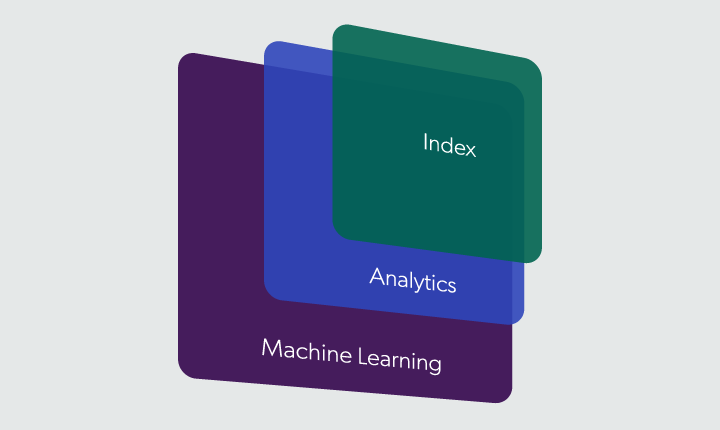With an edict to enable personalized experiences, it’s important to have a platform that is flexible enough to meet the myriad requirements that come from business groups.
Here we outline top considerations—and why Coveo is your optimal choice.
Global Footprint for Data Residency
First and foremost, you need a provider who operates where you do business. Coveo is in 50 countries across multiple regions, and has three primary locations in North America, Europe, and Australia. This means that multi-national organizations, bound by internal security policies and/or privacy laws, can choose their primary location for data processing and storage.
Additionally, our footprint includes regional data centers to handle user queries to reduce latency and handle data replication. Regardless of region, all Coveo Data Centers are updated multiple times each day and always run the very latest version of the Coveo Relevance Platform™.
Flexible Architecture for Multiple Use Cases
When striving for Customer 360 or “personalization across every touchpoint,” point solutions just can’t cut it. It’s important then, to have a vendor who has experience in a wide-variety of use cases whether it is digital commerce, multi-site search, intelligent customer service, or knowledge management.
Coveo is able to stretch from a simple interface for one use case to something a lot more complex. This flexibility comes from the power of the core Coveo platform.
The Coveo Platform core is composed of three main components: the Index, Analytics, and Machine learning. The index contains the content. Analytics is composed of the behavioral usage data (signals) that Coveo gathers. Machine Learning of course, provides the platform’s continuously learning intelligence.
The Unified Index can contain nearly any kind of information from user profiles, knowledge articles, google drive documents, youtube videos, or nearly any other data type you might want.
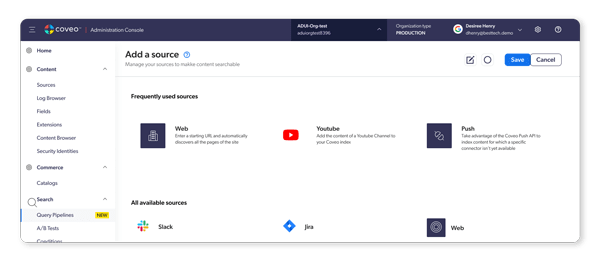
To make this easy Coveo provides around 28 connectors that crawl through different types of databases and data sources. This can be as easy as providing a Youtube channel URL. For more complex data sources, developers can use the Push API which allows them to drop data in JSON document format from any data source.
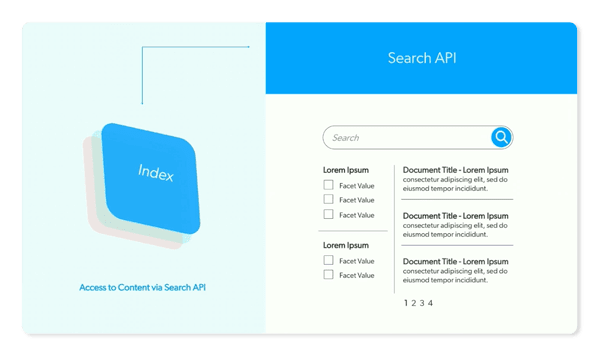
Content in the Coveo index lives in sources which are provided by connectors. This data is gathered using connectors which allow those sources to be crawled from wherever they are.
Library of Search Interfaces
Using the Search API
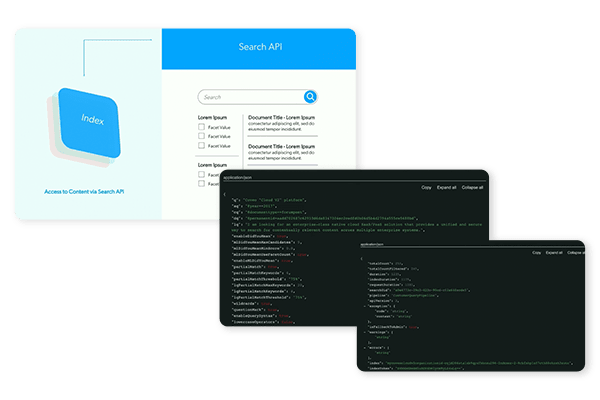
In order to use the data in the index to build intelligent functionality like a search interface, the first and main point of contact with the index is the Search API. Developers can directly use the search API but it is a fairly low-level interface.
Working with the search API requires the application to send JSON requests with the proper parameters. The index will send a response including a payload which can be a single document or list of search results, along with other information.
Using the Javascript Search Framework
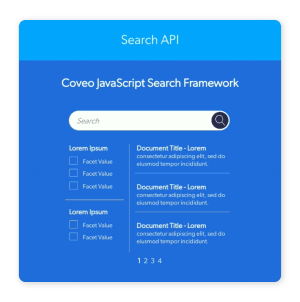
Many Coveo customers use the Search API directly, but it is not the only option. An easier option is Coveo’s Javascript Search Framework. This framework consists of a library of components that allows developers to create a complete search application that connects to indexed content with minimal setup.
For an excellent example of what is possible using the Coveo Javascript Framework visit FrancoSarto, a customer with a live implementation using this framework.
Using the Interface Editor
Another alternative is to use the Coveo Search Interface Editor. Even non-developers can create basic search interface by clicking a button from the administration console and setting a few basic parameters like “page title.” The interface can be further refined with facets and other UI components by dragging and dropping components into it.
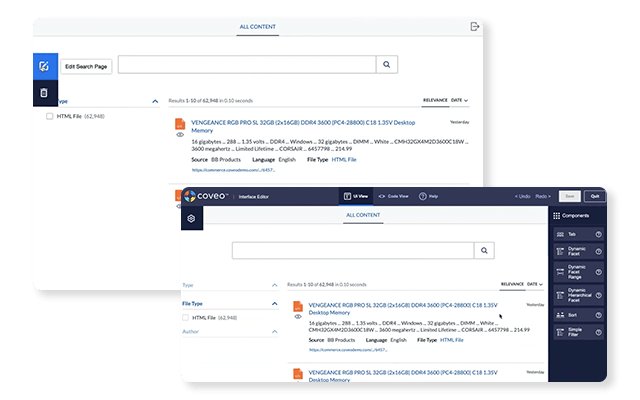
The Interface Editor is low-code tool, but not a black box. Developers can use the Code View feature to see the code the Interface Editor generates on their behalf,
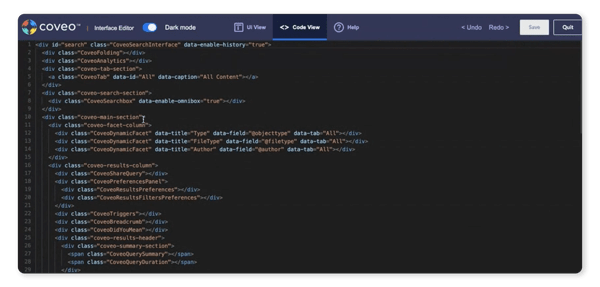
While the Interface editor creates a basic interface initially, by using the drag and drop interface, Coveo users can create full-featured search UIs without writing any code.
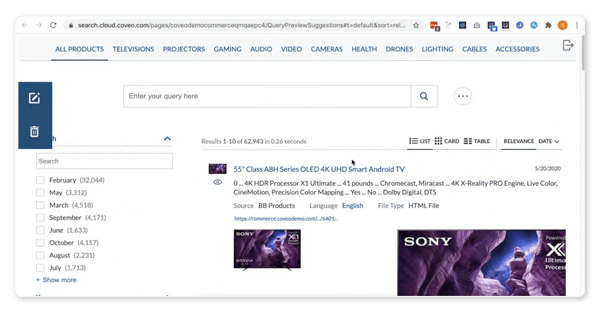
Using the Headless Component API
While the Interface Editor and Javascript Search Framework are powerful tools, highly experienced JavaScript developers familiar with tools like Angular and React may prefer to greater control of the look and feel of their JavaScript components. For these developers Coveo offers the Headless component library.
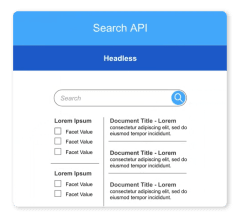
The Headless component library simplifies the Search API but doesn’t attempt to draw UI components. Essentially Headless manages the UI state with components like a “SearchBox” or “Facet” but allows the developer to take direct control over interaction with the user
For instance in the below code sample, the searchBox is updated to the text “hello” and then set to the first query suggestion, presumably “hello world.
import { SearchBox, buildSearchBox } from '@coveo/headless';
import { engine } from '../Engine';
const mySearchBox: SearchBox = buildSearchBox(engine);
searchBox.updateText('hello');
searchBox.selectSuggestion(searchBox.state.suggestions[0].value) Collecting Analytics
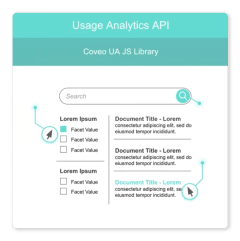
In parallel to the Search API and Javascript Search Framework, Coveo offers the Usage Analytics API and Coveo Usage Analytics Javascript API. These allow the developer to directly collect analytics information and update the index with things like what a user searched, clicked on or bought.
Developers who use the Javascript Search Framework, Headless or the Interface Editor, analytics are taken care of without any additional effort so long as the feature is enabled.
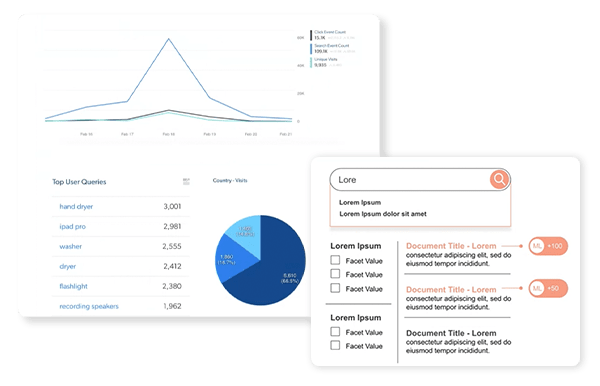
Using these analytics Coveo developers, administrators and analysts are able to visualize what users are doing as well as create their own dashboards.
Machine Learning
In addition to dashboards, Coveo’s commitment to analytic research on user behavior drives our machine learning expertise for personalization, recommendations, and other search-result improvements.
Coveo provides four core machine learning models including:
- Query Suggestions
- Automatic Relevance Tuning
- Recommendations
- Dynamic Navigation Experience
Query Suggestions
When a user types something in a search bar, they see a drop down suggesting what query they are about to type. These query suggestions are provided by a machine learning model based on the types of information in the index, how users of the index query it, and how a particular user is querying it.
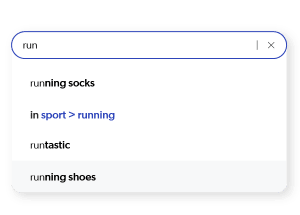
Automatic Relevance Tuning
Automatic Relevance Tuning (ART) boosts popular results based not only on what users searched on but what they actually clicked on. For instance if a user types “running shoes” then the most popular running shoes might be boosted to the top of the page. This is important for commerce where often queries are one word, but also important for more specific queries common in workplace and support use cases.
Recommendations

When a user selects a product or document, Coveo’s recommendation machine learning model can recommend similar product based on both description and what other users ultimately clicked on after searching for that item or even what they actually bought.
Dynamic Navigation Experience
Different items have different characteristics and so users filter on them with other types of facets. For instance, if a user searches on “monitor” they might want to search on size or interface type (i.e. USB-C, Thunderbolt, HDMI, VGA). If that same user searches on “laptop” then size and processor speed might be more important. Rather than requiring painstaking ordering by product marketers or data analysts, Coveo’s machine learning model is able to figure out what filters are most popular or relevant to what customers are searching on.
Conclusion
Coveo’s core platform is composed of a unified index, analytics, and machine learning. Coveo’s connectors are able to parse numerous types of data, but developers can also use the Push API to import data from any source. The platform provides developers with multiple ways to interact with the index including the Search API, Javascript Search Framework, Interface Editor and the Headless Search Framework.
In parallel, the platform provides developers ways to provide usage information to the platform using the Usage Analytics API or the Usage Analytics Javascript Framework. These analytics not only power visualizations and dashboards, but also Coveo’s powerful machine learning models which automatically suggest queries, related documents, boost relevant results and the relevant facet types based on search type.
This is just a sample of what Coveo has to offer. To learn more watch the Relevance 360 Rewind webinar “Connect your enterprise with the Coveo Relevance Platform” or get started with a Coveo Trial.

